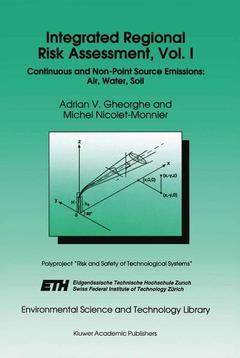Description
Integrated Regional Risk Assessment, Vol. I, 1995
Continuous and Non-Point Source Emissions: Air, Water, Soil
Environmental Science and Technology Library Series, Vol. 4
Authors: Gheorghe A.V., Nicolet-Monnier M.
Language: English
Subjects for Integrated Regional Risk Assessment, Vol. I:
Keywords
158.24 €
In Print (Delivery period: 15 days).
Add to cart
Publication date: 10-2012
343 p. · 16x24 cm · Paperback
343 p. · 16x24 cm · Paperback
Description
/li>Contents
/li>
Industrial development is essential to improvement of the standard of living in all countries. In a given region, old and new plants, processes, and technologies have to coexist. Technological penetration and substitution processes are generally taking place; they are entirely dynamic and this trend is going to stay like this. People's health and the environment can be affected, directly or indirectly by routine waste discharges or by accidents. A series of recent major industrial accidents and the effect of pollution highlighted, once again, the need for better management of routine and accidental risks. Moreover, the existence of natural hazards complicate even more the situation in any given region. In the past effort to cope with these risks, if made at all, have been largely on a plant by plant basis; some plants are well equipped to manage environmental hazards while others are not. Managing the hazards of modern technological systems has become a key activity in highly industrialized countries. Decision makers are often confronted with complex issues concerning economic and social development, industrialization and associated infrastructure needs, population and land use planning. Such issues have to be addressed in such a way that ensures that public health will not be disrupted or substantially degraded.
1: Framework for the Analysis and Assessment of Regional Emissions.- 1.1. Introduction.- 1.2. Identification of Continuous Emission Sources.- 1.3. Non-point Source Emissions.- 1.4. Population and Meteorological Data.- 1.5. Media and Modes of Environmental Transfers.- 1.6. Integration of Environmental Data.- Summary (Chapter 1).- References (Chapter 1).- 2: Atmospheric Dispersion Models and Methods.- 2.1. Introduction.- 2.2. Environmental Dispersion Models.- 2.3. Computer Codes for Atmospheric Dispersion Modeling.- 2.4. An Environmental Decision Support System “Inter-CLAIR”.- Summary (Chapter 2).- References (Chapter 2).- 3: Models and Risk Assessment Methods for the Hydrological Cycle.- 3.1. General Information on Model Types.- 3.2. Risk Assessment for Groundwater Pollution Control.- 3.3. Groundwater Models.- 3.4. Water Quality Assessment.- 3.5. Guidelines for Drinking Water Quality.- 3.6. Resource Prediction and Management Models.- 3.7. Waste Loads Management.- 3.8. Commercial Software for Water Models.- Summary (Chapter 3).- References (Chapter 3).- 4: Models and Assessment Methods for Environmental Exposure and Health Impacts.- 4.1. Assessment of Continuous Emissions Impacts to the Environment.- 4.2. Environmental Exposure Assessment Methods for Chemicals.- 4.3. Models and Computer Based Tools for Integrated Regional Risk Assessment.- 4.4. Estimates of Risks from Continuous Emissions - The Dose-Response Relationship.- 4.5. Estimates of Risks from Accidental Gas Releases.- 4.6. Environmental Guidelines and Their Value to Risk Management.- Some Additional Comments.- Summary (Chapter 4).- References (Chapter 4).- 5: Towards Integrated Risk Assessment and Safety Management at Regional Level.- 5.1. The Potential Use of Comparative Risk Assessment.- 5.2. SomeMethodological Issues in CRA for Severe Accidents.- 5.3. Basic Aspects in Decision Aiding Techniques.- Summary (Chapter 5).- References (Chapter 5).- Appendix A: Compilation of U.S. Emission Factors.- Appendix B: Sample Calculations.- a) Emission From an Elevated Continuous Point Source.- b) Emission from Elevated Instantaneous Point Sources (Puff).
© 2024 LAVOISIER S.A.S.



